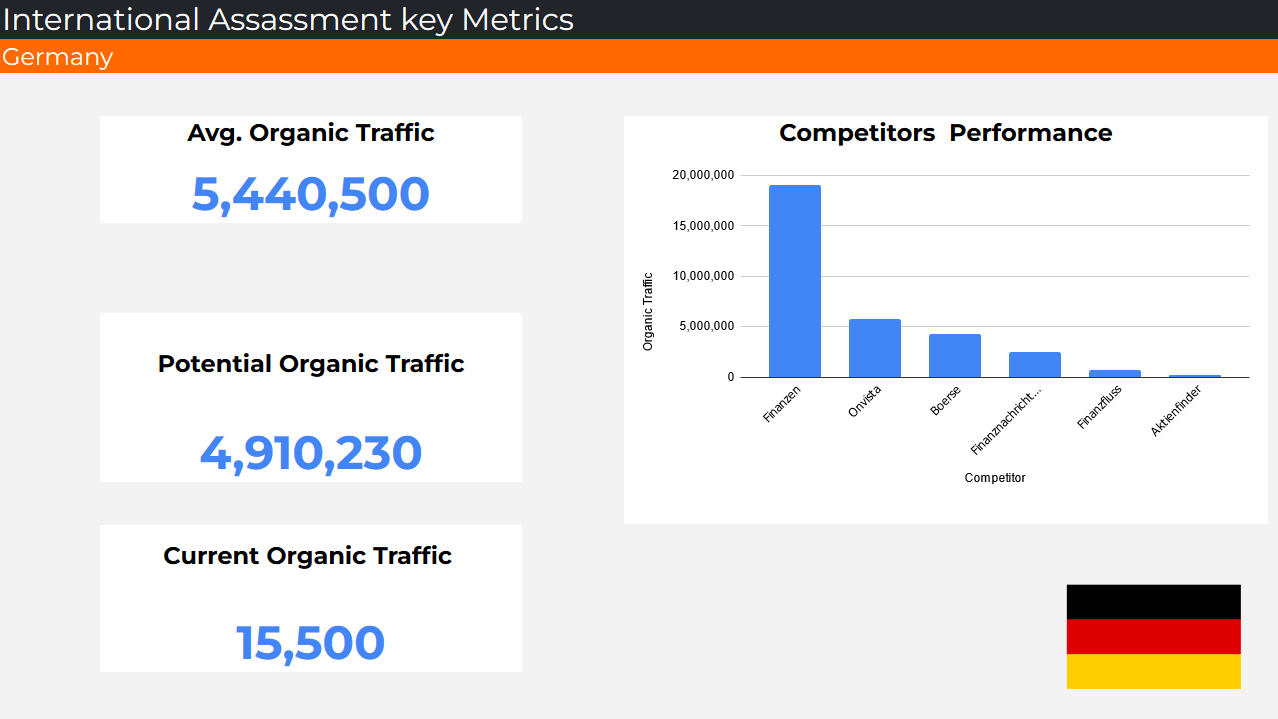How many websites are you familiar with that are truly global?
You can probably think of a few, and some of the largest online companies will likely come to mind including the likes of Facebook or Amazon, a few large travel sites (like TripAdvisor, Booking, or OTPs like Expedia and Kayak), or some of the largest SaaS enterprise companies.
But for virtually everyone outside of these “giant” categories, it’s a missed opportunity.
One of the best ways to grow your business is by expanding your market, and there’s a lot of potential in specific local markets throughout the world. Expanding your online business to a global scale can help you reach a much wider audience and grow much faster.
As two examples, have a look at Facebook and Airbnb. Facebook attributes their most significant growth in its first 10 years to translations. They’ve implemented a new platform to automatically translate Facebook into hundreds of languages, by their users.
Airbnb started going global in 2011, they’ve assembled a global translation team and went global within months. Only later Airbnb started opening local offices around the world.
Why don’t we see many more companies succeed at going global with SEO?
First, many companies aren’t even thinking of going global as an actual opportunity. Then, some are even afraid to try because they don’t know how or where to begin, and of course, there are companies that have tried going global but failed. This isn’t necessarily due to the company’s size or budget restraints, it’s often down to a failure in executing, and even acknowledging, some vital steps that are needed to succeed with a totally different country, a different culture. It really all comes down to a lack of experience.
Many online companies that try going global are looking at some basic cultural differences, but here, you need more than just the basics. Converting the currency or tweaking the colors isn’t enough anymore to make locals feel they can trust your online brand.
These companies translate, and while Translation is a crucial step, it’s only a first step to consider. Translating the texts will make your website readable, but not necessarily offer the kind of value the local market will appreciate.
They think they have SEO and marketing covered, but international SEO requires more than just picking the right URL structure and adding hreflang tags. If your site doesn’t rank in a specific country right now, then simply launching a brand new website for it and adding the right tags from your original site won’t cut it.
What websites should take into account to succeed at going global
To scale globally, you need to be ready to make some serious adjustments, and take every country into account individually. When I ran SEO back at Investing.com, we used to have 30 localized editions in 23 different languages. Four offices around the world, and local employees for most language editions.
Our international websites were responsible for over 70% of the total traffic, and going global is what allowed the website to grow to over 300 million monthly sessions.
Local research
For every single country or region you wish to enter, start with local research. The purpose is to decide whether to enter that local market or not.
A few questions to answer:
- How many potential users are out there?
- What do these users currently rely on?
- Will your current business model work in this new country?
- How will you handle support for local customers?
- Are you legally authorized to bring your product, use your brand name, hire the needed people, and monetize it?
Pro tip: You can use your own Facebook page to get insights, by narrowing down your audience to a specific country. This is a great way to get insights from locals who already know and use your product.
You need to really understand the local market, their habits, how they use the web (and mobile), if and how they buy online, and how they engage with products like yours.
Local competition
Understand who the other players in the market are.
- Who is getting your potential users’ attention right now?
- What exactly do they offer?
- What are they best at and what are their deficiencies?
- Which pages and products drive most of their traffic and business?
- What is their marketing strategy? With a full traffic source breakdown.
- Reviews: What do people really say about them, both online and offline.
If you decide to expand, then:
Hire local
This is probably the most important step. You have to hire local employees and make sure they speak your language too, for best communication between you two. In many cases, they can of course be freelancers. Be sure they have an in-depth understanding of the local culture, the local online habits, and hopefully, at least some familiarity with your very specific industry.
When it comes to your new employees’ language skills, make sure you can trust that it’s appropriate and with the correct dialect. This is more important than you may think.
Your local employee should be the one to approve all translations, make sure that all aspects of your site are well-tailored to your specific audience, and be your point of contact for absolutely everything involving that market.
Local adjustments
Some adjustments will be required, and they could mean different metric systems, but also cultural and attitudinal differences that should be taken into account.
Convert weight measurements if you’re selling items. In most countries, people don’t know what lbs are since they use kilograms instead. Celsius vs. Fahrenheit is very confusing as well. Take currencies into account and don’t forget that dates are formatted differently as well. Is 08/05 May 8th, or August 5th?
Depends where you ask…
Colors as signals
In finance, for most locations green indicates an upward trend whereas red means the opposite. Green makes investors happy, red is bad. That’s simple.
In South Korea and China, however, we learned the hard way that it’s actually red that signifies an upward trend. You don’t need to know all of that, what you need is to know to ask these questions, and not take things that are obvious to you for granted elsewhere.
When it comes to attitudinal differences, every market is different. Germans for example are very concerned about their privacy and often don’t provide their real full names online. This might impact your registration forms.
From the product point of view, make sure you’re able to offer what locals want. If you’re in eCommerce, then it’s the specific products the locals want.
Menus
Adjust them to the local focus.
First by common sense, gleaned from your original research, but then again once you gather some data.
Design
For some countries, you’ll need to consider a different design. In China, where very dense design is common, users actually prefer to open all links as new tabs, primarily because the internet is so slow in many areas, and that allows users to keep the original page open. For more design differences examples, browse through a few Japanese sites.
Hosting
Whether it’s shared or dedicated, you’ll want to make sure you have local hosting. Especially if you’re expanding into a new continent.
Local marketing strategies
SEO
Google isn’t the most popular search engine in all parts of the world so confirm which one it is for your next country and learn about the differences. Especially Yandex or Baidu.
Hreflang tags are very important and can help search engines understand which local version to serve in every location. However, hreflang tags can’t be a substitute for local marketing, brand awareness, and even just brand mentions and links for every separate local website.
Make sure to identify the correct keywords and topics. If a popular English search term isn’t common in French, it doesn’t mean French people don’t look for the topic, it might just mean they have a different way of saying it. This is how our International SEO Opportunity Report started. One of the very first steps we go through when exploring a new market, is figuring out these keywords and these differences. This is step one. Your entire content strategy will be built based on this.
Choosing the right URL structure is also important, particularly since it will be harder to change it later on. The two most popular options are ccTLDs and subdomains. If you opt for ccTLDs, keep in mind that:
- Your websites will be tracked separately by others and not as a single website
- In the future, you may not be able to get all of your desired domains. This means you might end up having both ccTLDs and Subdomains in your network
PR
Since public relations is based on interactions between people, you need to pay additional attention to cultural differences. Definitely consult your local employees on this. How to approach, through which medium, and how often to follow up should all be checked. Remember those Germans who are very concerned about their privacy!
Burden of translation: Many publishers and blogs find it difficult to go global because they require massive translations. Translating a significant number of articles, especially those that have a short shelf life, such as news, is both complicated and expensive. The biggest challenge here is to identify the top 10%-20%, to begin with.
Who can benefit by going global?
Almost everyone. This includes smaller sites as well as websites with a large number of pages that are updated automatically by a feed or by the community. Ecommerce, booking, recipes, reviews, SaaS companies, and many more types of websites can benefit from global exposure.
How to identify, quantify, and prioritize using SEO keyword data
While we’ve discussed multiple factors to consider when deciding which country to expand to first, one of the first things you’d want to do is check the SEO potential for your market in the various languages. Now it’s time to dive in.
To do this, we’re going to run through a process we’ve created called our International SEO opportunity report, which eventually will look like this:
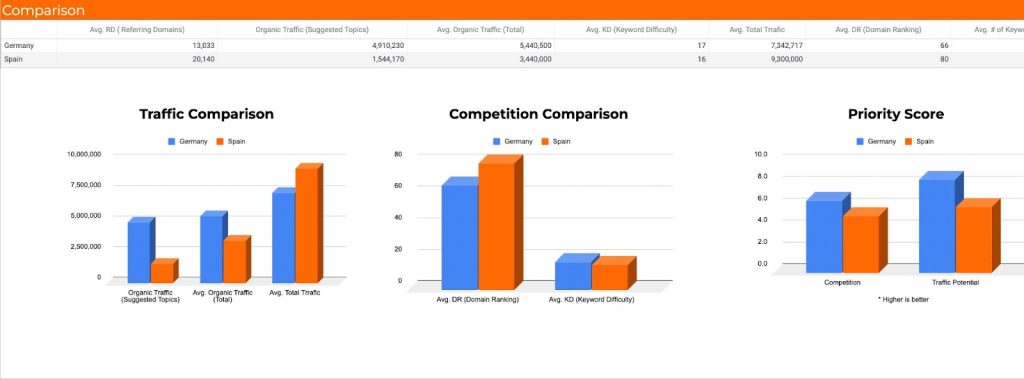
This approach gives us a high-level overview, by language, of the size and shape (i.e. competitiveness) of the topic set. We look at this by the highest volume keyword, for each language we’re considering. Search volume is by no means the most important metric in SEO, but remember, here we are looking to understand the market size in a given language. No other considerations for now.
The process is fairly straightforward, but it does require some work.
First, we will identify the current high-performing topics using Ahrefs’ Top Pages report and GSC Query report.
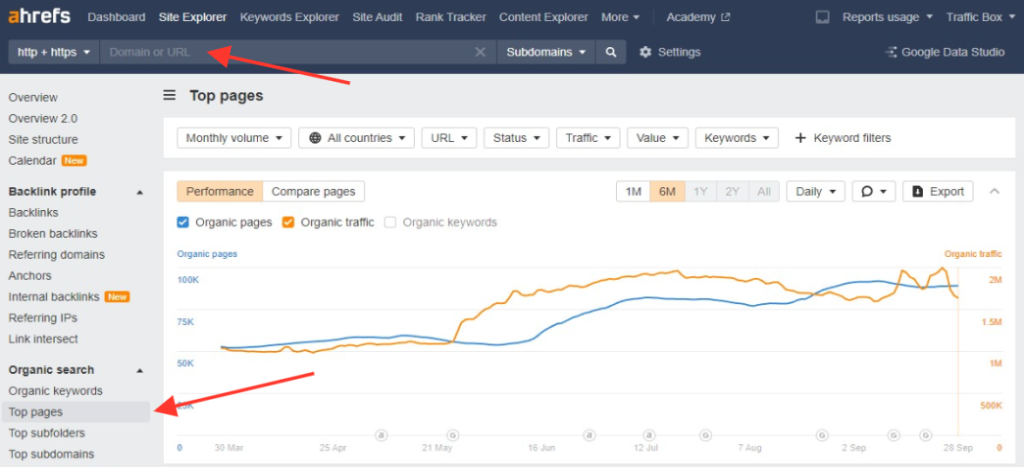
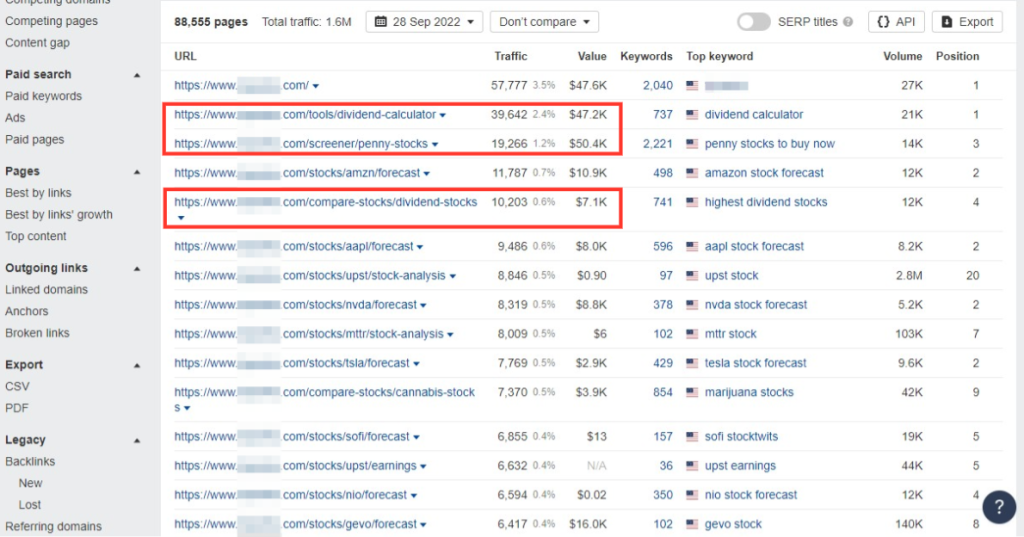
For larger sites, you’ll have to run the top 1,000 queries from GSC in an Ngram analyzer to find your patterns easily.
The GSC query report will provide you with the top 1,000 non-branded Keywords:
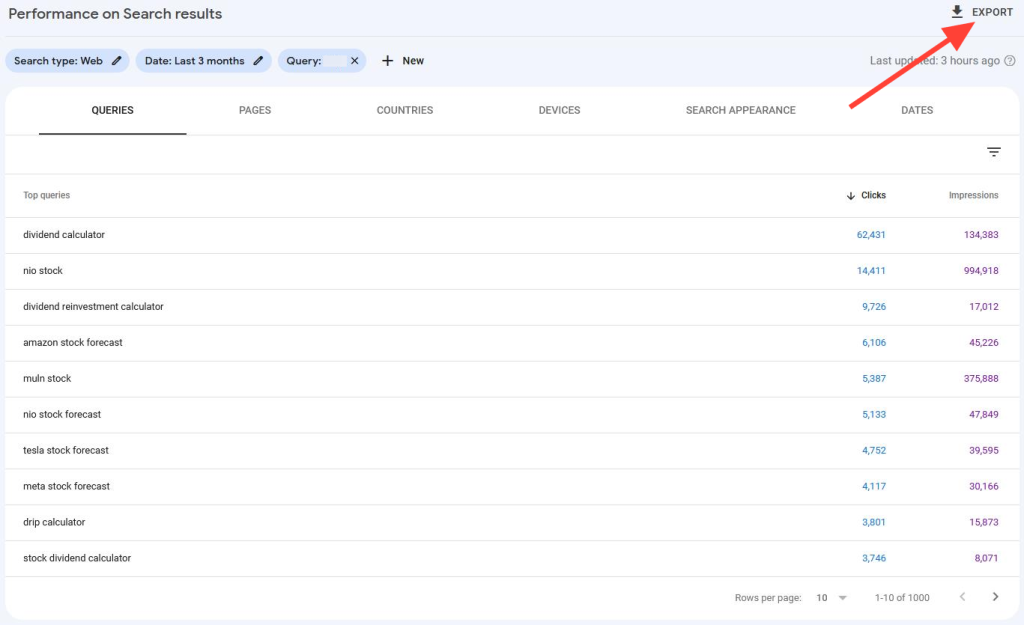
Next: Add the Keywords to an Ngram Analyzer (The free, Online NGram Analyzer will do it)
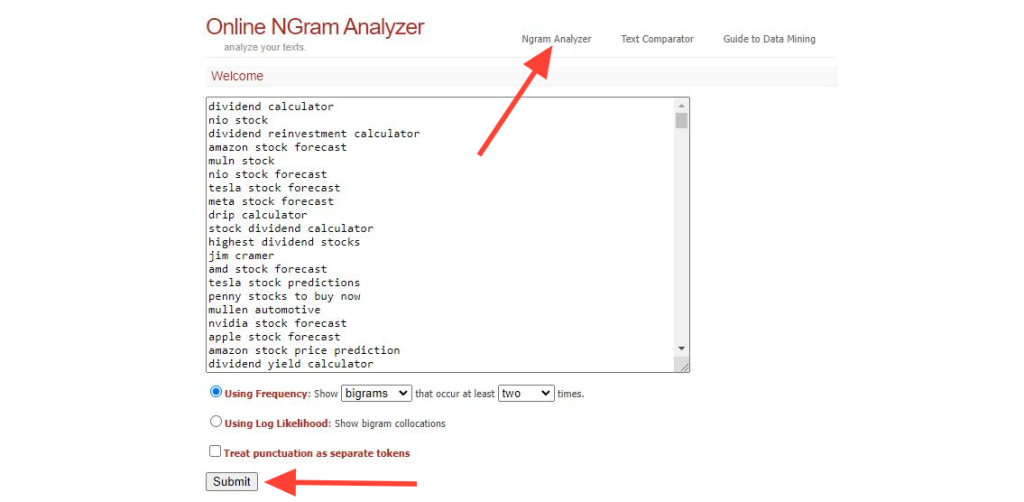
And spot patterns and repetitive phrases:
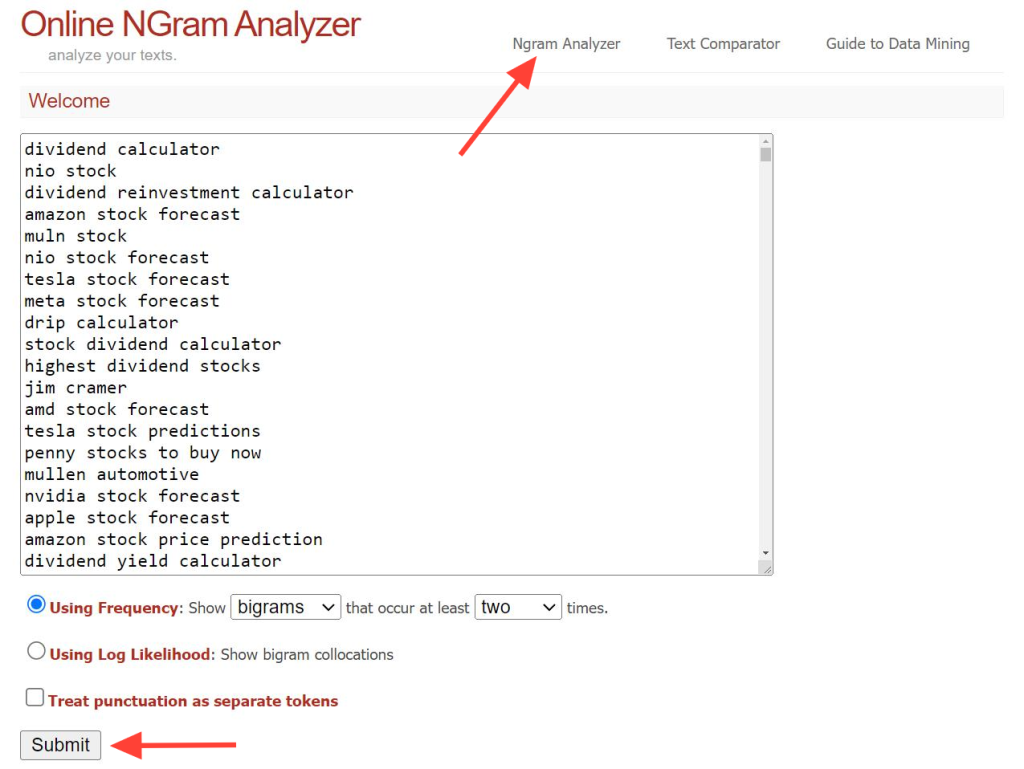
Next, add the list of priority topics in a dedicated tab in Google sheets with the following Ahrefs metrics: MSV, KD, CPC, Traffic potential, and Global Search Volume.
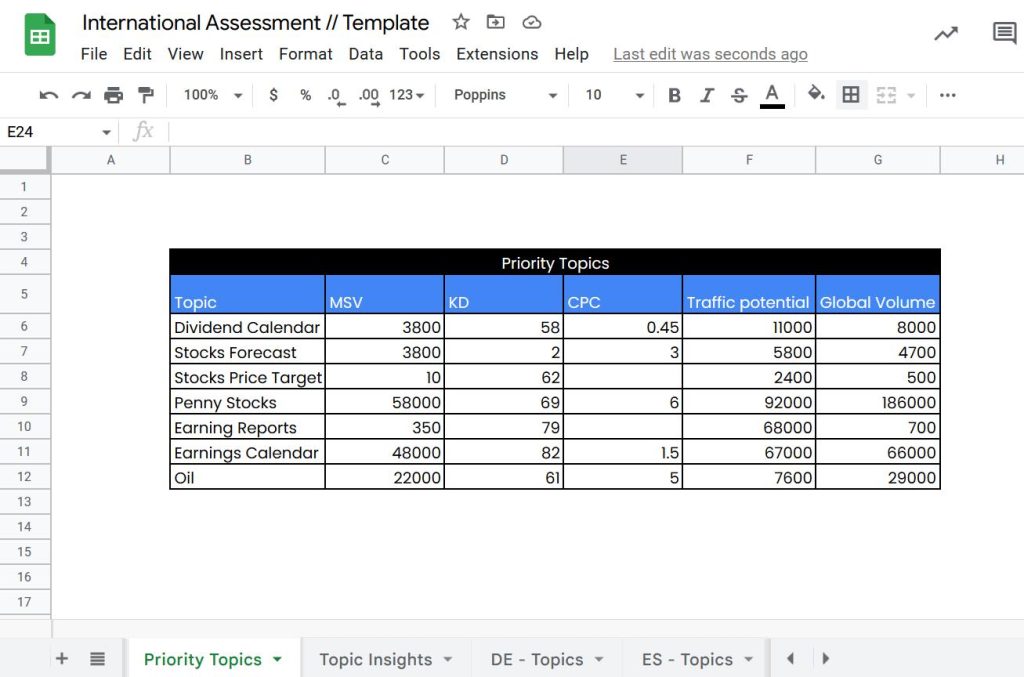
Now, after identifying the topics and pages we want to focus on, we will research the equivalent phrases in other languages.
Here starts the interesting part.
Translate each topic to the preferred language using DeepL or Google translate (we prefer DeepL for multiple reasons, but that’s not crucial for the point we’re making here).
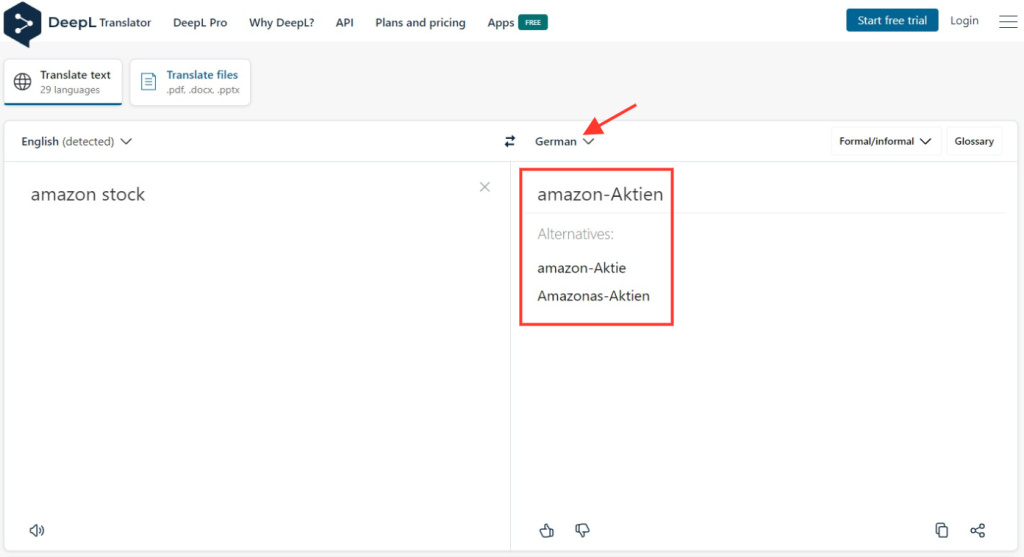
Then, copy and paste all the variations into the Google Keyword Planner (The Google Keyword Planner is very efficient here as it will remove the wrong variations and will help find the right related keywords in one go).

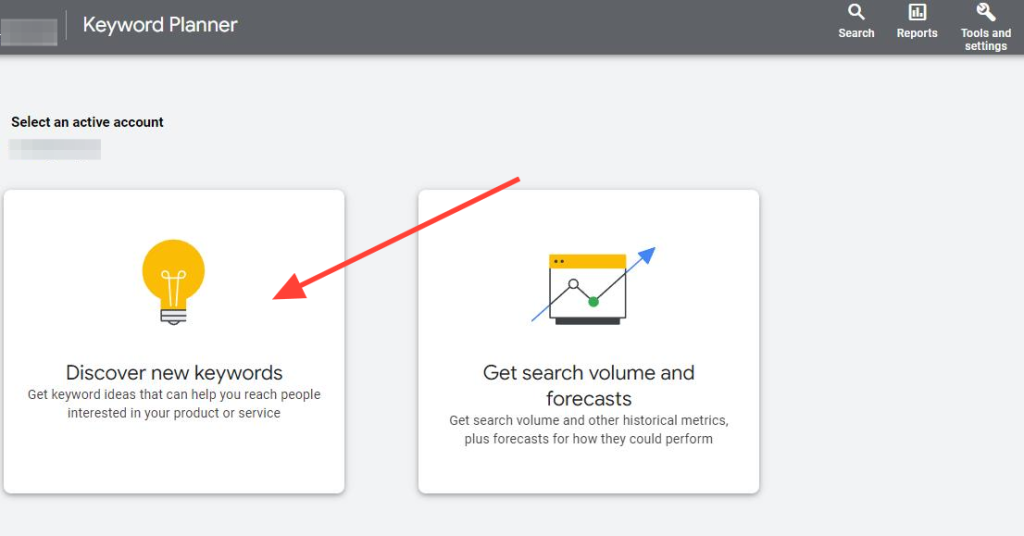
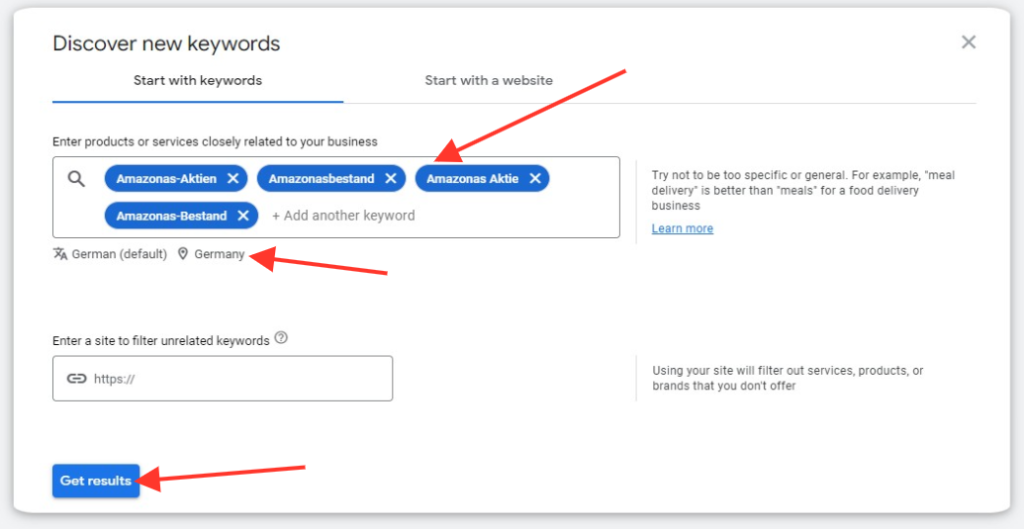
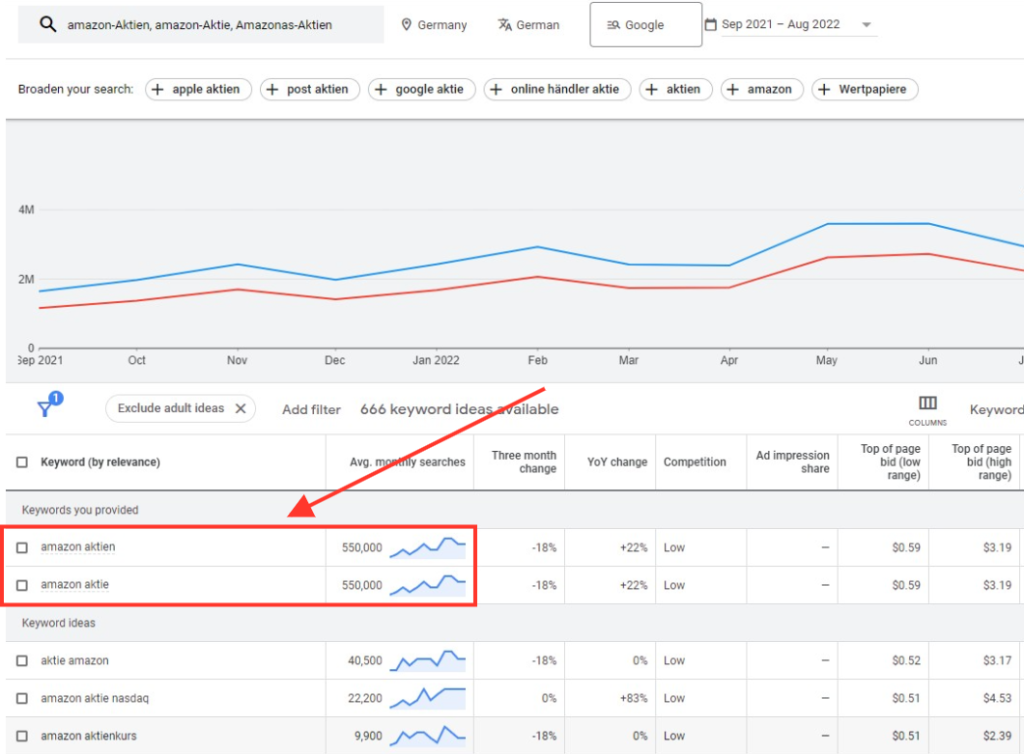
Now, repeat this step for each topic! Yep.
In cases where the keyword volume isn’t significant, Search on Google for the top variation and list the first relevant result. Then, run the URL in Ahrefs’ Site Explorer and try to extract a better seed keyword from the Organic Keyword section (We are searching for the same intent, but with a higher search volume).
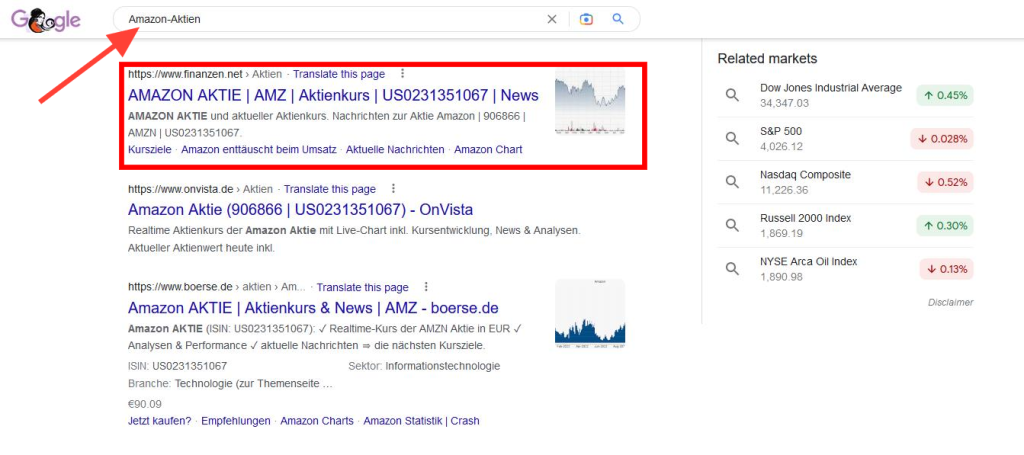



Add the list of topics to a dedicated tab, for example, ‘DE – Topics’, and add the following metrics from Ahrefs’ Keyword Explorer report – MSV, KD, CPC, Traffic Potential & Global Volume.
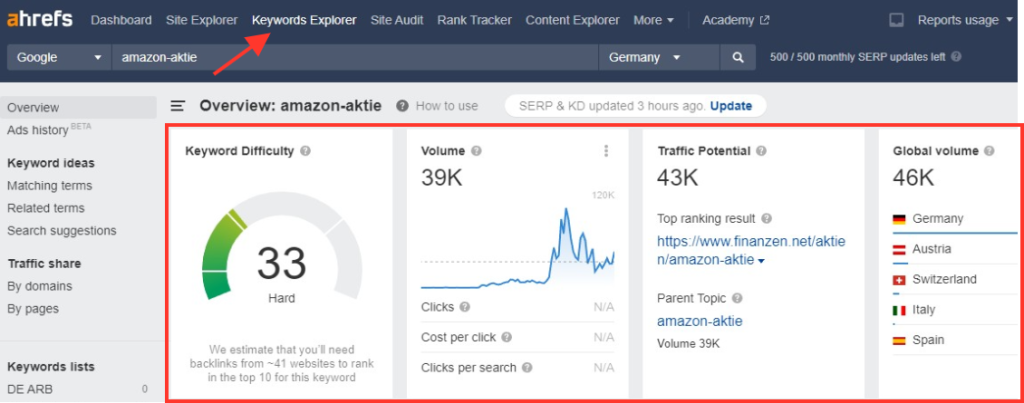
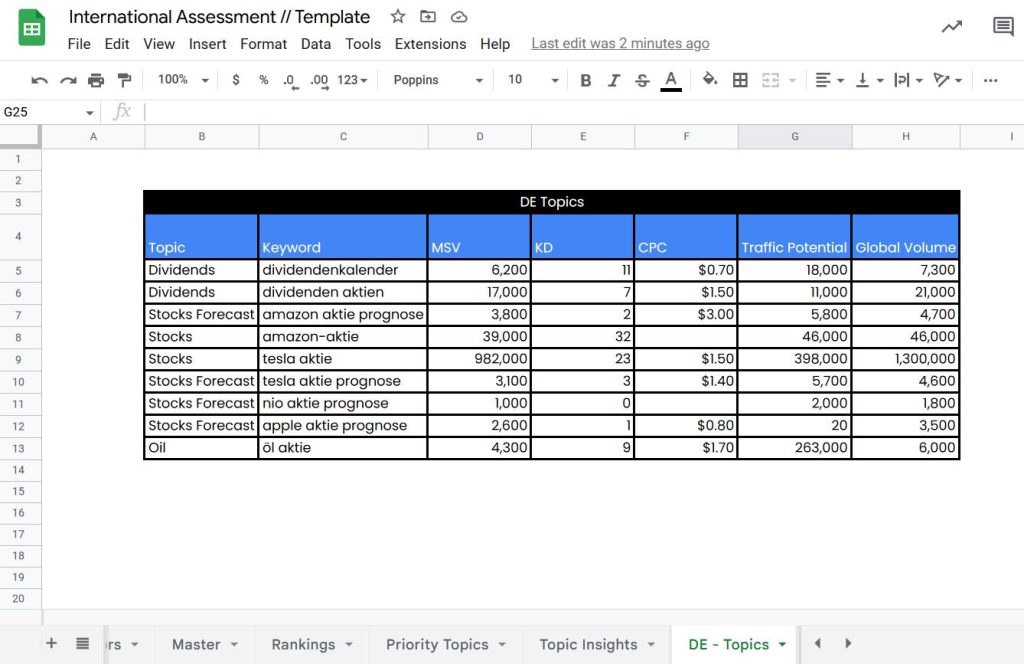
Next, you need to extract the first position’s URL, per topic, using Ahrefs Keyword Explorer, and add it to a competitor’s list for this specific country.
Add the following metrics from Ahrefs Site Explorer – DR, RD, Number of Keywords, and Organic Traffic. You can also add total traffic from SimilarWeb. If you don’t have a Pro account, the free data in the browser extension will provide you with the same data.
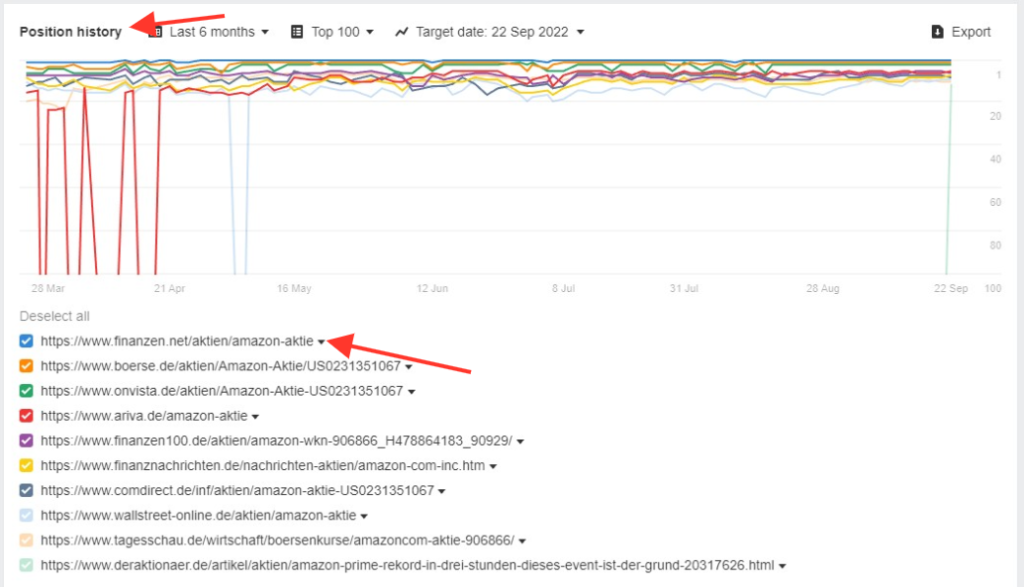
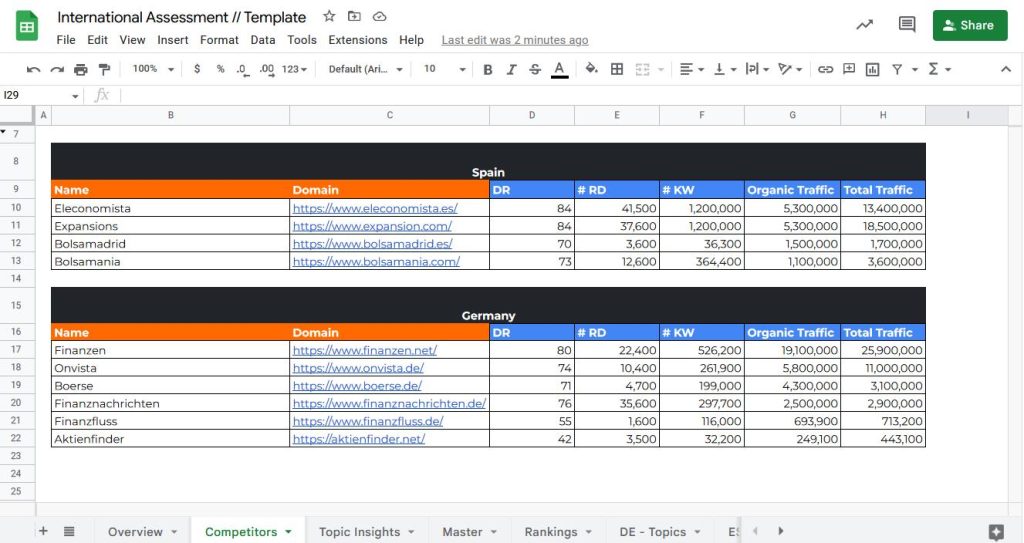
Download the Organic Keywords per competitor URL and add the data to dedicated tabs with the following Naming convention – “{Country Code} – {Topic} – {Competitor Name}”:

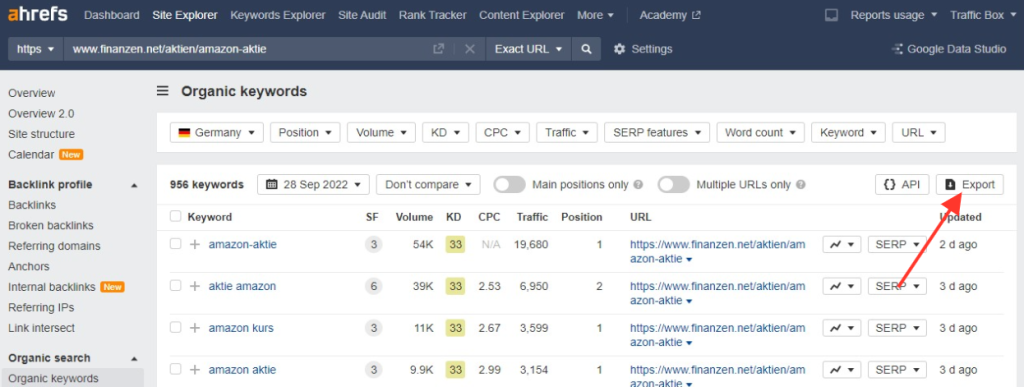
Combine all the Keywords into a single tab and remove duplicates. Run all the Keywords in Ahrefs Keyword Explorer and download the Ahrefs data into a new Tab ( {Country Code} – {Ahrefs Data}
Create a “Master” tab and combine all the data we collected with the following metrics:
- Country
- MSV (Monthly Search Volume)
- KD (Keyword Difficulty)
- CPS (Clicks Per Search)
- Clicks (calculated)
- Traffic Potential
- Global Volume
Optional, add CPC from the GKP Group (High level) for the Keyword on the Master tab using the Priority Topics in English:
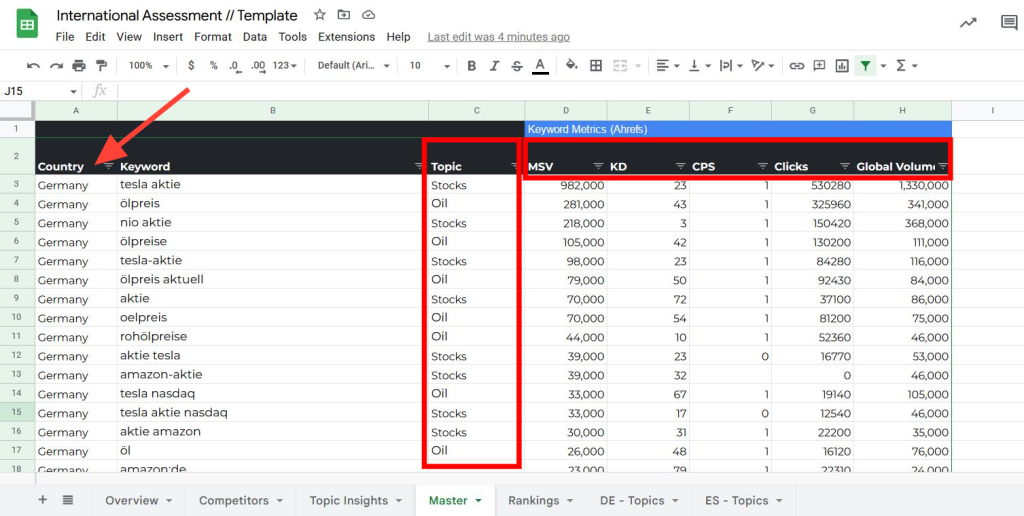
Now, repeat these steps for each country.
Priority Score
After we collected all the data needed for our International assessment, we will start ranking each country.
Based on the averages we’ve received for the metrics, we can now suggest a ranking system between 1 to 10 for each key data point, for both Competition data points, and Traffic Potential. This will require you to manually rank each of them, but it’s all based on the totals you have. Lower competition values will give you a better ranking, just as higher traffic potential, that will also increase the ranking.
This internal ranking system will help you evaluate the potential of each country.
Here is what it looks like:
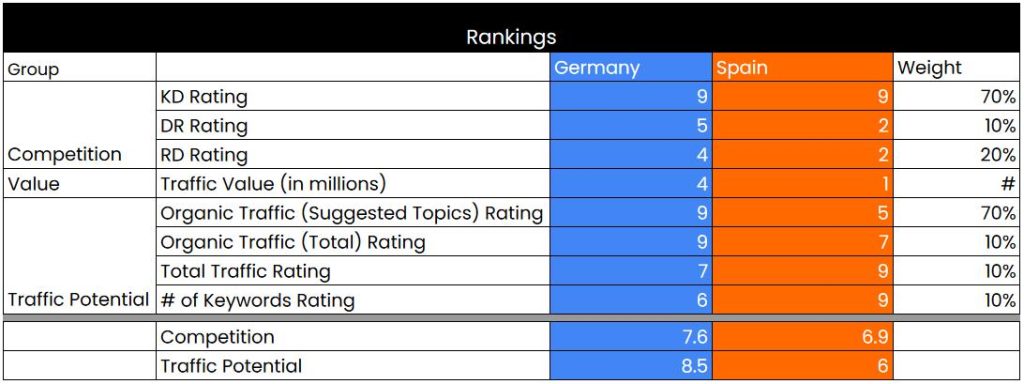
Now, just compare your findings, to make a true priority list for your upcoming languages.
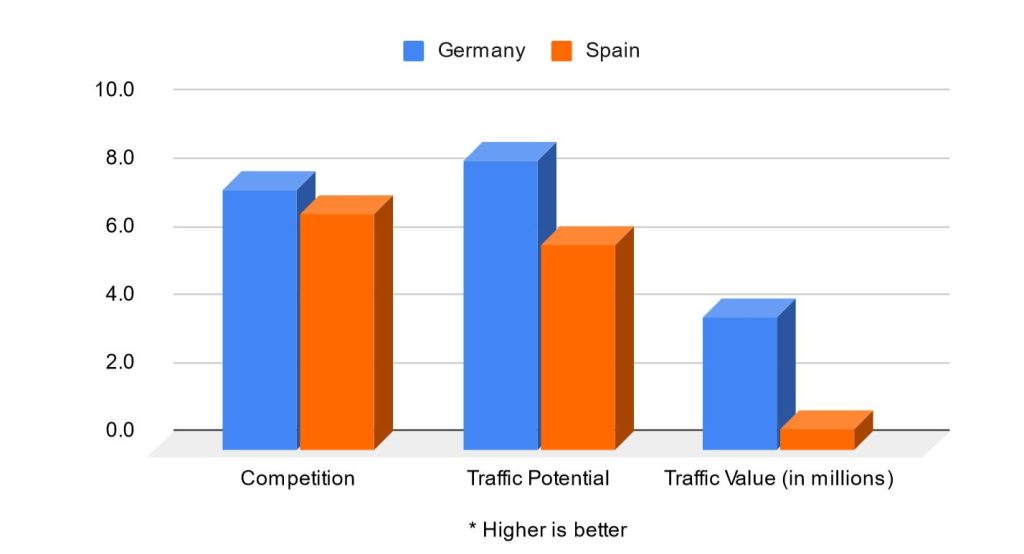
Conclusion
Going global isn’t easy. You must begin with thorough research and continue with extra attention to all the small details relevant to each country or market. It’s a lot of work, but it’s also very rewarding if done properly. Remember, the only way to become truly global is to make sure you’re truly local everywhere you go.
Webify is an International Focused SEO Agency, we help you spot global opportunities, understand what’s needed to get there, then execute.
Igal Stolpner co-founded Webify after leaving his role as VP Growth at Investing.com, where he started as the first employee back in 2007, and left when the company was sold in 2021.
Igal led the company’s growth from zero to over 250M monthly sessions, with over 50% of traffic coming from organic search, taking it from zero to among the top 200 sites globally.

